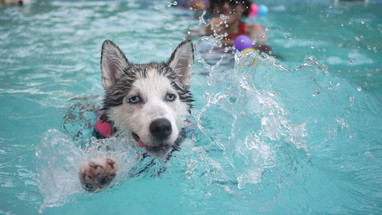Dog Walking Alternatives
Looking to mix up your daily routine and still keep your pet active? Loving Pets would like to share a few quick alternatives to walking your dog.
Just like children, dogs can get bored or routine, and often boredom begets destructive behavior, including excessive barking, digging, and chewing. It’s important to provide your dog time for exercise and play for mental and physical stimulation. While most pet parents opt for the classic walk, a change of routine can provide a new experience and increase mental stimulation for your pet. Here are a few alternatives to walking your dog.
Jumping, Agility and Obstacle Courses Just about anything around the house can but used to set up an agility course for dogs – cardboard boxes, couch cushions, hula-hoops, etc. If your pet is unaccustomed to agility work, start with a very simple course, such as weaving in and out of a line of dowels (or other household objects). Once the course is mapped out, lead your dog through the various obstacles using treats as encouragement. Use small treats that are easy to chew and digest. Agility work is a stimulating workout both mentally and physically, and helps keep them confined to a safe area. Pay close attention to your dog’s condition during the exercise so as not to cause overexertion in sensitive pets. Dogs with flat noses can have trouble breathing when fatigued, while larger breeds and older dogs may be more susceptible to ligament injuries and arthritis.
Swimming If you have a natural water dog like a Chesapeake Bay retriever or an English setter, swimming is a natural a no-brainer. However, even dogs that are not naturally accustomed to the water can still learn to love swimming activities if encouraged from a young age. A designated dog beach is an ideal environment to frolic in the waves. Play it safe by checking for signs of strong currents and encouraging your pet to stay close to shore. Always conclude ocean swimming with a freshwater rinse to rid coat and paws of excess salt and sand. If swimming in a lake or pool, make sure your dog doesn’t go straight for the deep end, as he may not be able to get out of the water without help. As with any swimming activity, never leave your dog unsupervised; even breeds accustomed to the water can get tired and drown. When swimming in any body of water, don’t forget to pack a large dog water bowl and plenty of fresh water so he doesn’t resort to drinking seawater or other water that may contain parasites.
Treadmills If you have a dog that gets spooked on walks or live in a cold-weather state where walks are sometimes simply not an option, getting your dog to walk on a treadmill might be a good middle ground. Start by getting your dog accustomed to the sound of a running treadmill (this might take awhile). Next, turn off the treadmill and give him treats to encourage him to stand on the treadmill on his own. Choose a low calorie treat that won’t cause indigestion while exercising. Once he is okay with standing on the treadmill, start it on the lowest speed and continue giving treats. Although you may use a leash to guide your dog, NEVER tie to the leash to the treadmill. Once your dog is comfortable, you may gradually increase to speed depending on your dog’s endurance level and overall health condition.
Dog Sports Depending on the area you live in, there may be several organized sporting outlets for your dog such as flyball, competition Frisbee, tracking, hearing, or weight-pulling. These can be great bonding experiences for you and your dog. However, your dog’s temperament and breed type will dictate whether these sports are appropriate. The American Kennel Club (http://www.akc.org/events) has an extensive list of events near your area and is a great resource for dog sporting.
There are many alternatives to walking your dog. With a little creativity, your furry companion can get his exercise and stimulate his brain with new and exciting activities. A healthy exercise program will not only reduce common behavior problems, but also improve your dog’s overall physical condition.



